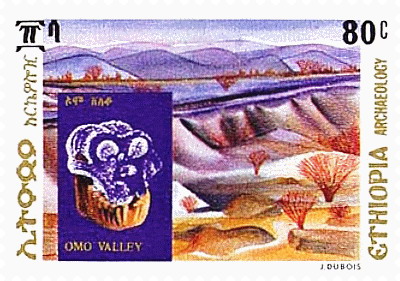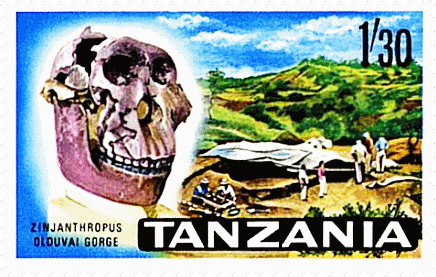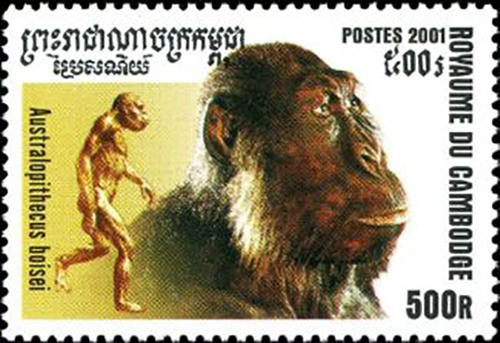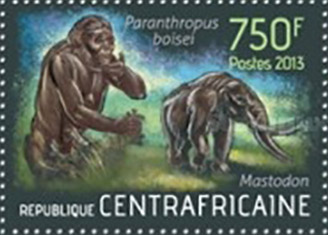Paranthropus boisei Mary Leakey, 1959

Phylum: Chordata Haeckel, 1874
Classe: Mammalia Linnaeus, 1758
Ordine: Primates Linnaeus, 1758
Famiglia: Hominidae Gray, 1825
Genere: Paranthropus Broom, 1938
Descrizione
Il primo fossile di Australopithecus boisei, inizialmente classificato come Paranthropus boisei e chiamato Zinjanthropus boisei, venne identificato da Mary Leakey nel 1959 nella gola di Olduvai in Tanzania. La scoperta avvenne il 17 luglio 1959 nella gola di Olduvai in Tanzania, ad opera dell'antropologa Mary Leakey. Il fossile (OH 5, che sta per Olduvai Hominid number 5), comprendeva un teschio completo, risalente a circa 1,8 milioni di anni, che aveva le caratteristiche corrispondenti ad un Australopithecus robustus. Mary e il marito Louis Leakey classificarono la scoperta come Zinjanthropus boisei, dove Zinj derivava da Zanj, il nome dato dagli Arabi ai neri dell'Africa orientale che riducevano in epoca medievale in schiavitù, anthropus che in greco significa uomo e boisei da Charles Boise, che aveva sovvenzionato il team di ricerca. L’Australopithecus boisei era un abitante della savana e delle boscaglie. Le dimensioni ricostruite per gli esemplari adulti indicano un peso di 65 kg per i maschi, con un'altezza attorno a 130 cm; le femmine pesavano sui 45 kg con un'altezza di 105 cm. Le differenza tra le dimensioni dei due sessi è tipica del dimorfismo sessuale che caratterizza quasi tutte le specie di australopiteci. Il volume del cervello probabilmente poteva arrivare a 530 cm³, non era cioè molto maggiore di quello dell'Australopithecus afarensis o dell'Australopithecus africanus. La struttura robusta del cranio indicava una specializzazione masticatoria e aveva molti tratti in comune con un odierno gorilla. I molari posteriori erano molto grandi, più del doppio di quelli di un uomo moderno. Fu soprannominato "Uomo schiaccianoci" proprio perché i suoi denti sono i più grandi e il suo smalto il più spesso tra tutti gli ominidi finora ritrovati. Questa morfologia cranio-dentale indica una dieta a base di cibi vegetali duri come tuberi, noci e semi. L'analisi del tipo di usura e microfessurazioni dei molari sembra invece indicare che i cibi duri non fossero una componente regolare della dieta dell'Austrolapithecus boisei, ma che venissero utilizzati in assenza di altre tipologie di cibo. Louis Leakey ipotizzò che questo esemplare potesse essere in qualche modo collegato al genere umano. La comunità scientifica non condivise il suo giudizio.
Diffusione
Vissuto tra 2,6 e 1,2 milioni di anni fa nell'Africa orientale durante il Pliocene e il Pleistocene.
Bibliografia
–"Paranthropus boisei Topics". Smithsonian National Museum of Natural History. 2010-02-14. Retrieved 11 July 2012.
–Morell, Virginia (2011). Ancestral Passions: The Leakey Family and the Quest for Humankind's Beginnings. Simon & Schuster. p. 185. ISBN 9781439143872.
–Watson, Peter (2002). The Modern Mind: An Intellectual History of the 20th Century. New York: Perennial. pp. 486-487. ISBN 978-0-06-008438-7.
–Evernden, J. F.; Curtis, G. H. (1965-10-01). "The Potassium-Argon Dating of Late Cenozoic Rocks in East Africa and Italy [and Comments and Reply]". Current Anthropology. 6 (4): 342-385.
–Glen, William (1982). The Road to Jaramillo: Critical Years of the Revolution in Earth Science. Stanford University Press. pp. 76. ISBN 978-0-8047-1119-7.
–Friend, Tim (January 23, 1997). "Oldest stone tools yet found in Ethiopia". USA Today (LIFE): 1.
–Journal of Eastern African Research and Development. East African Literature Bureau. 1974. p. 129. The mandible was discovered by Kamoya Kimeu in 1964, during an expedition conducted by Richard Leakey and Glynn Isaac.
–Virginia Morell (11 January 2011). Ancestral Passions: The Leakey Family and the Quest for Humankind's Beginnings. Simon and Schuster. p. 303. ISBN 978-1-4391-4387-2.
–Wood, Bernard; Lieberman, Daniel E. (2001). "Craniodental variation in Paranthropus boisei: A developmental and functional perspective". American Journal of Physical Anthropology. 116 (1): 13-25.
–McHenry, Henry M.; Coffing, Katherine (2000). "Australopithecus to Homo: Transformations in Body and Mind" (PDF). Annual Review of Anthropology. 29 (1): 125-46.
–Findings Challenge Conventional Ideas on Evolution of Human Diet, Natural Selection Newswise, Retrieved on June 26, 2008.
–Klein, Richard G. (1999). The Human Career: Human Biological and Cultural Origins (2nd ed.). Chicago: University of Chicago Press. ISBN 978-0-226-43963-1.
–Ungar, Peter S.; Grine, Frederick E.; Teaford, Mark F. (April 2008). Petraglia, Michael (ed.). "Dental Microwear and Diet of the Plio-Pleistocene Hominin Paranthropus boisei". PLoS ONE. 3 (4): e2044.
–"Gnashers at Work". The Economist. 2008-05-01. Retrieved 2008-05-05.
–Scott, Robert S.; Ungar, Peter S.; Bergstrom, Torbjorn S.; Brown, Christopher A.; Grine, Frederick E.; Teaford, Mark F.; Walker, Alan (2005). "Dental microwear texture analysis shows within-species diet variability in fossil hominins". Nature. 436 (7051): 693-5.
–Daegling, David J.; Judex, Stefan; Ozcivici, Engin; Ravosa, Matthew J.; Taylor, Andrea B.; Grine, Frederick E.; Teaford, Mark F.; Ungar, Peter S. (July 2013). "Viewpoints: feeding mechanics, diet, and dietary adaptations in early hominins". American Journal of Physical Anthropology. 151 (3): 356-71.
–Wood, Bernard; Schroer, Kes (2012). "Reconstructing the Diet of an Extinct Hominin Taxon: The Role of Extant Primate Models". International Journal of Primatology. 33 (3): 716-42.
–Ungar, Peter S.; Sponheimer, Matt (2011). "The Diets of Early Hominins". Science. 334 (6053): 190-3.
–
–Cerling, Thure E.; Mbua, Emma; Kirera, Francis M.; Manthi, Fredrick Kyalo; Grine, Frederick E.; Leakey, Meave G.; Sponheimer, Matt; Unoa, Kevin T. (2011). "Diet of Paranthropus boisei in the early Pleistocene of East Africa". Proceedings of the National Academy of Sciences. 108 (23): 9337-41.
–New technologies challenge old ideas about early hominid diets[unreliable source?] Archived August 5, 2013, at the Wayback Machine.
–Macho, Gabriele A. (2014). "Baboon Feeding Ecology Informs the Dietary Niche of Paranthropus boisei". PLoS ONE. 9 (1): 84942.
–Griffith, Cameron S.; Long, Byron L.; Sept, Jeanne M. (2010). "HOMINIDS: An agent-based spatial simulation model to evaluate behavioral patterns of early Pleistocene hominids". Ecological Modelling. 221 (5): 738-60.
–Wood, Bernard; Constantino, Paul (2007). "Paranthropus boisei: Fifty years of evidence and analysis". American Journal of Physical Anthropology. 134 (Suppl 45): 106-32.

|
Data: 19/01/1982
Emissione: Le origini dell'Umanità Stato: Kenya |
|---|

|
Data: 15/03/1977
Emissione: Archeologia in Etiopia 5 v. Stato: Ethiopia |
|---|

|
Data: 09/12/1965
Emissione: Motivi locali 13 v. Stato: Tanzania |
|---|

|
Data: 21/10/2001
Emissione: Uomini preistorici Stato: Kampuchea (People's Republic) |
|---|

|
Data: 10/06/2013
Emissione: Uomini preistorici Stato: Central African Republic Nota: Emesso in un foglietto di 4 v. diversi |
|---|